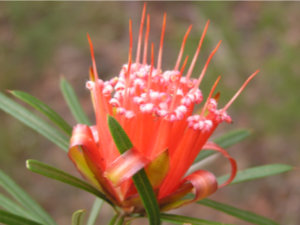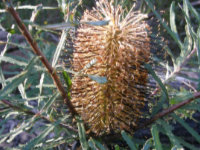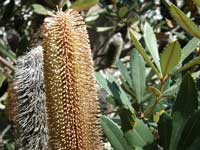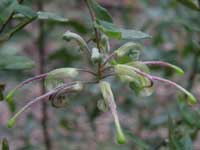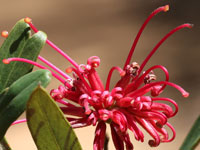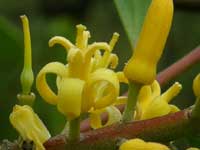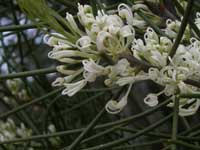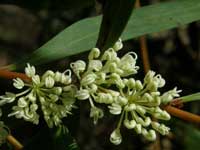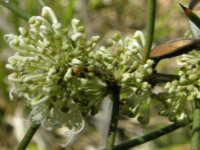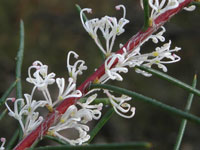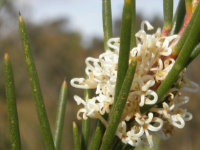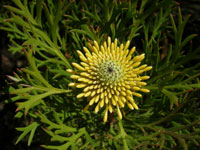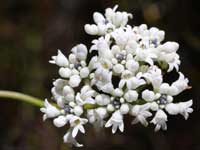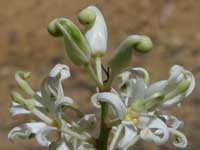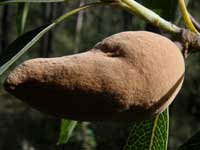We acknowledge the traditional custodians of the land on which these plants grow - the Darug and Gundungurra people - and pay respect to their Elders past, present and emerging.
Although the Proteaceae family is "only" the fifth largest of Australia flora in terms of the number of species, it boasts some of the most popular and well known species including the Waratah and Old Man Banksia.
The Grevillea genus, with over 380 species, is the third largest flora genus in Australia - after Acacia and Eucalyptus.
There's over 80 species of the Proteaceae family in the Blue Mountains.
Note: Images marked as LCNP were taken in the Lane Cove National Park.
Banksias - Geebungs - Grevilleas - Drumsticks & Conesticks - Hakeas - Smoke Bushes - Mountain Devil - Woody Pear - Waratah - other genera
- Banksias
- Banksia cunninghamii
- Coast Banksia *
- Fern-leaved Banksia
- Hairpin Banksia
- Heath Banksia
- Hill Banksia
- Newnes Plateau Banksia
- Old Man Banksia
- Silver Banksia
- Swamp Banksia
- White Mountain Banksia
- Geebungs
- Broad-leaved Geebung
- Lance Leaf Geebung
- Laurel-leaf Geebung
- Mountain Geebung
- Narrow-leaved Geebung
- Needle Geebung
- Persoonia recedens
- Soft Geebung
- Grevilleas
- Bog Grevillea
- Evans Grevillea
- Green Spider Flower
- Grevillea aspleniifolia
- Grey Spider Flower
- Juniper Grevillea
- Laurel-leaf Grevillea
- Pink Spider Flower (ssp. riparia)
- Pink Spider Flower (ssp. sericea)
- Rosemary Grevillea
- Red Spider Flower
- Woolly Grevillea
- Hakeas
- Blacknose
- Dagger Hakea
- Finger Hakea
- Hakea constablei
- Hakea laevipes
- Hakea pachyphylla
- Needlebush
- Small-fruited Hakea
- Willow-leaved Hakea
* introduced species
- Banksia collina
- Banksia cunninghamii
- Banksia ericifolia subsp. ericifolia
- Banksia integrifolia subsp. integrifolia *
- Banksia integrifolia subsp. monticola
- Banksia marginata
- Banksia oblongifolia
- Banksia paludosa subsp. paludosa
- Banksia penicillata
- Banksia serrata
- Banksia spinulosa
- Conospermum ericifolium
- Conospermum longifolium subsp. longifolium
- Conospermum longifolium subsp. mediale
- Conospermum taxifolium
- Conospermum tenuifolium
- Grevillea acanthifolia subsp. acanthifolia
- Grevillea aspleniifolia
- Grevillea evansiana
- Grevillea juniperina
- Grevillea lanigera
- Grevillea laurifolia
- Grevillea mucronulata
- Grevillea oleoides
- Grevillea phylicoides
- Grevillea rosmarinifolia subsp. rosmarinifolia
- Grevillea sericea subsp. riparia
- Grevillea sericea subsp. sericea
- Hakea constablei
- Hakea dactyloides
- Hakea laevipes
- Hakea microcarpa
- Hakea pachyphylla
- Hakea propinqua
- Hakea sericea
- Hakea salicifolia
- Hakea teretifolia
- Isopogon anemonifolius
- Lambertia formosa
- Lomatia myricoides
- Lomatia silaifolia
- Persoonia acerosa
- Persoonia chamaepitys
- Persoonia lanceolata
- Persoonia laurina subsp. laurina
- Persoonia levis
- Persoonia linearis
- Persoonia mollis subsp. mollis
- Persoonia recedens
- Petrophile pulchella
- Petrophile pedunculata
- Symphionema montanum
- Telopea speciosissima
- Xylomelum pyriforme
* introduced species
There are eleven Banksia species in the Blue Mountains - this includes the introduced Coast Banksia (Banksia integrifolia subsp. integrifolia.
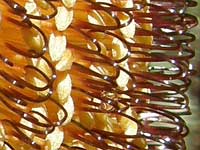 Banksia hooked styles
Banksia hooked styles
The first lesson is to disregard juvenile leaves - as they can be vastly different to the mature leaves used to identify plants - as this image of the seedlings of a Heath Banksia shows.
To assist in identification, the Banksias below are grouped into key identifiers.
The leaves distinguish these four from each other. Until a few years ago, B. collina and B. cunninghamii were varieties of B. spinulosa.
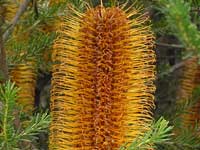
Heath Banksia
Banksia ericifolia subsp. ericifolia
Its 10-15mm long rosemary like leaves identify it.
Heath Banksias don't regrow after fire; they depend on seedlings.
Banksia ericifolia subsp. macrantha lives on the NSW North Coast.
Also see our Heath Banksia web page.
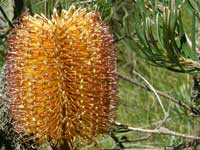
Hairpin Banksia
Banksia spinulosa
Its recurved 2mm wide leaves identify it. The leaves tend to be clustered at the end of branches and point upwards like fingers on a hand.
Here's another image and another.
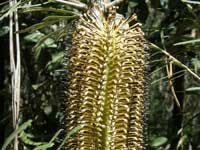
Banksia cunninghamii
Banksia cunninghamii doesn't regrow after fire; it depends on seedlings.
Straightish styles and leaves in regular whorls distinguish these three from other Blue Mountains banksias. The three species are uncommon.
The leaves of the Swamp Banksia and Newnes Plateau Banksia help to distinguish them from each other. Note the difference in the number of teeth, lateral veins, how the leaves taper and the hairs.
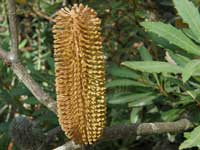
Swamp Banksia
Banksia paludosa
subsp. paludosa
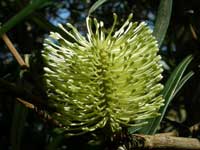
White Mountain Banksia
Banksia integrifolia
subsp. monticola
Its whorls of leaves, leaves themselves and small light yellow cone help identify it.
White Mountain Banksias regrow after fire. Here's another image.
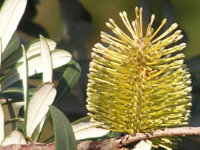
Coast Banksia
Banksia integrifolia
subsp. integrifolia
It can be found along the east coast but is not a native of the Blue Mountains.
Plants at Echo Pt and on the highway in Katoomba, at Gordon Falls and next to Bullaburra Station were planted there.
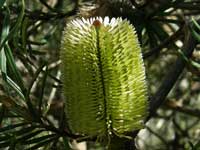
Silver Banksia
Banksia marginata
Here's another image and another.
Silver Banksias don't regrow after fire; they depend on seedlings.
See our Silver Banksia webpage.
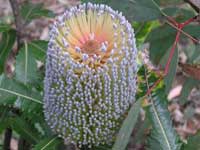
Old Man Banksia
Banksia serrata
Its distinctive cream cones in late summer with serrated leaves - all growing on a wonderfully gnarled tree identifies it.
Here he is covered in dew.
Old Man Banksias regrow after fire and also have seedlings.
See our Old Man Banksia webpage.
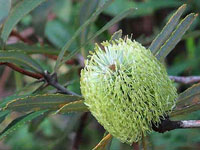
Fern-leaved Banksia
Banksia oblongifolia
It's a 2-3m high scrub.
Its bluish perianth also identifies it.
See our Fern-leaved Banksia webpage.
There's some 22 species of the Grevillea genus in the Blue Mountains.
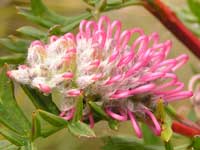
Bog Grevillea
Grevillea acanthifolia
subsp. acanthifolia
Here's another image.
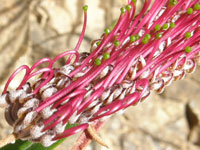
Grevillea aspleniifolia
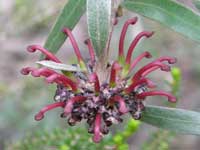
Evans Grevillea
Grevillea evansiana
It is identified by its "felty" leaves and crimson flowers.
This plant was found in Wollemi National Park. Here's another image.
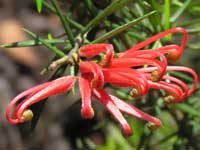
Juniper Grevillea
Grevillea juniperina
There are seven identified subspecies; the one shown here is most probably ssp. trinervis - identified by its Blue Mountains location, its red colour and the width of its leaves - > 1mm.
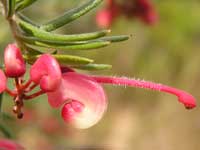
Woolly Grevillea
Grevillea lanigera
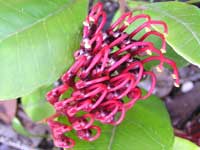
Laurel-leaf Grevillea
Grevillea laurifolia
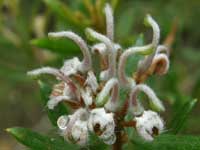
Grey Spider Flower
Grevillea phylicoides
It also lacks the little appendage at the end of its legs (styles). The foot-like pads at the end of the style are greeny-grey, where the (G. buxifolia)'s are a reddy-brown grey.
Here's another image.
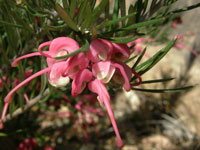
Rosemary Grevillea
Grevillea rosmarinifolia
subsp. rosmarinifolia
Here's another image.
Here's Peter Olde's Rediscovering Grevillea rosmarinifolia article.
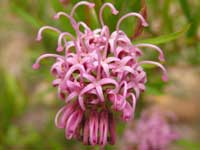
Pink Spider Flower
Grevillea sericea subsp. sericea
A Pink Spider Flower on a bad
Here's another image and another.
Also see our Spider Flowers web page.
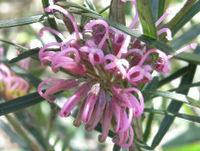
Pink Spider Flower
Grevillea sericea subsp. riparia
Here's another image.
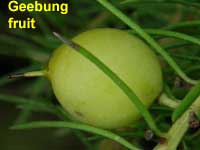
There are some 20 species in the Blue Mountains.
Their distinctive bright yellow flowers in summer and fruit (drupes) distinguishes them from any other genus.
They are known to hybridize, so identifying a species is not always straight forward.
The word Geebung has been immortalised in Banjo Paterson's poem The Geebung Polo Club.
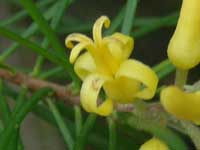
Narrow-leaved Geebung
Persoonia linearis
Here's another image.
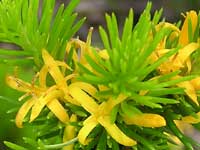
Mountain Geebung
Persoonia chamaepitys
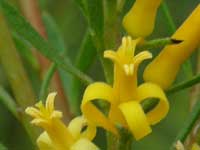
Persoonia recedens
It is a threatened species, and is mainly found in the upper Blue Mountains.
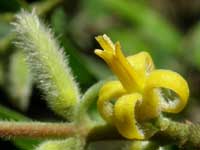
Soft Geebung
Persoonia mollis subsp. mollis
There are nine subspecies - but this is the one most frequently found in the upper Blue Mountains.
Here's a close-up image.
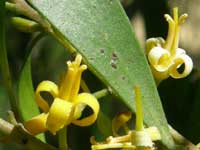
Lance Leaf Geebung
Persoonia lanceolata
The pedicel (flower stalk) is 3mm long and the unfurled tepal (outer surface of flower) is 11mm long.
Here's another image.
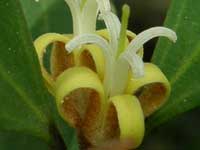
Laurel-leaf Geebung
Persoonia laurina subsp. laurina
There are three subspecies. Subsp. laurina has smooth leaves.
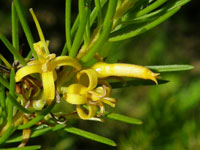
Needle Geebung
Persoonia acerosa
Here's another image.
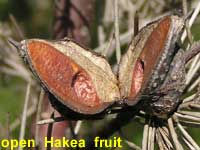
There's 10 species recorded as being in the Blue Mountains. The species not shown here is the critically endangered Kowmung Hakea (H. dohertyi) which only occurs in the Kanangra Boyd National Park and southern Blue Mountains National Park.
Their distinctive woody fruit (seed capsule) distinguishes them from other genera. The fruit does not open until the branch supporting it dies. The exception to this in NSW is the Small-fruited Hakea (H. microcarpa) whose fruit opens on maturity.
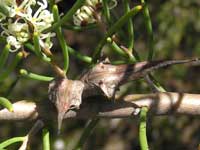
Dagger Hakea
Hakea teretifolia
Also called Needlebush.
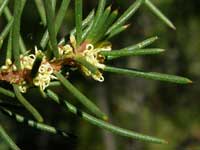
Hakea pachyphylla
Here's another image.
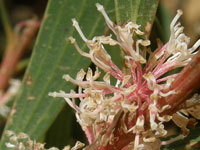
Finger Hakea
Hakea dactyloides
Also called the Broad-leaved Hakea.
Similar to Hakea laevipes.
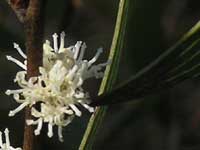
Hakea laevipes
It also flowers later than the Finger Hakea.
Being lignotuberous means that it may have multiple branches as the result of a bushfire.
- also see our Drumsticks & Conesticks web page.
There are 35 species of the Isopogon genus - all endemic to Australia. 7 are in NSW with 5 in the Blue Mountains.
There are 63 species of the Petrophile genus - all endemic to Australia. 4 are in NSW and the Blue Mountains.
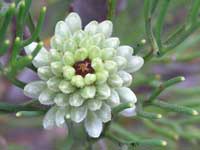
Conesticks
Petrophile pulchella
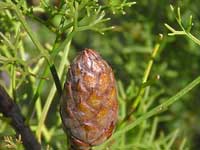
Stalked Conesticks
Petrophile pedunculata
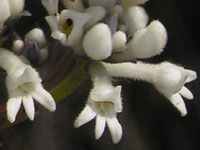
There are about 50 species of the Conospermum genus - all endemic to Australia.
Seven species/subspecies are recorded as being in the Blue Mountains.
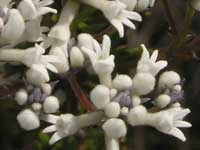
Variable Smoke-bush
Conospermum taxifolium
C. taxifolium is distinguished from C. ericifolium by its wider leaves - > 1mm.
As with other Blue Mountains smoke bush species, it flowers in spring.
Here's another image and another.
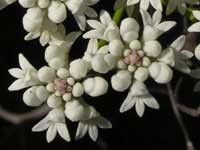
Long Leaf Smoke Bush
Conospermum longifolium
subsp. longifolium
This subspecies is uncommon in the Blue Mountains.
The third subspecies. C. longifolium subsp. angustifolium is primarily found south-east of the Blue Mountains.
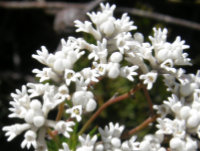
Conospermum ericifolium
Its terete leaves are about 10mm long and 1mm wide.
Of note was its blue sepals - which I can’t find any reference of.
PlantNet comments - “Intermediates between this species and C. taxifolium are found in areas where they grow together.”
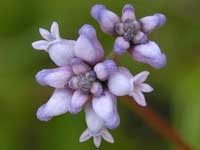
Sprawling Smoke-bush
Conospermum tenuifolium
The lilac coloured flowers are about 10mm wide and appear in spring.
saving the best until last!?
There are 6 other genera in the Blue Mountains with 8 species in total.
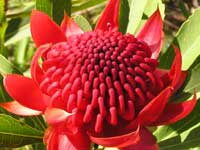
Waratah
Telopea speciosissima
The crimson flowers appear in spring and are 15cm in diameter. Truly magnificent. Its mainly serrated leaves aren’t opposite.
Waratahs regrow after fire from their lignotubers. These seedpods on a Narrow Neck Plateau waratah appeared two years after the Black Summer Bushfires.
Also see our Waratah web page.
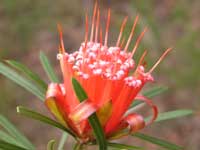
Mountain Devil
Lambertia formosa
Its woody fruit, shaped like a devil, gives it its name.
Even without flowers, its pungent pointed recurved sessile leaves identifies it.
Mountain Devils have lignotubers and bounce back quickly after a bushfire.
Also see our Mountain Devil web page.
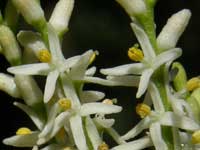
Mountain Symphionema
Symphionema montanum
Species are identified by their "ternate" leaves (leaves divided into 3).
S. montanum has flatter leaves than S. paludosum and has a distinct mid-vein.
The Mountain Symphionema is mainly found in the upper Blue Mountains.
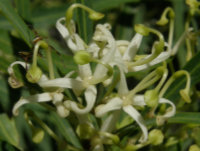
River Lomatia
Lomatia myricoides
Its leaves with their staggered teeth announce it as a lomatia. The leaves are up to 20cm long, and may not be toothed.
Also known as the Long-leaf Lomatia, it flowers in summer.

